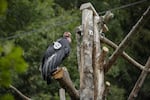
A California condor named Kaweah is pictured at the Oregon Zoo in this file photo from 2018.
Miranda Daviduk / OPB
The endangered California condor is ready to return to the skies of the Pacific Northwest after a century’s absence.
The U.S. Fish and Wildlife Service, the Yurok Tribe and the National Park Service announced Tuesday they will establish an experimental population of California condors in the Yurok ancestral territory. A final rule published by the Fish and Wildlife Service will allow the tribe to build a condor release facility in Redwood National Park.
The announcement marks a monumental step forward for a bird once on the brink of extinction and for the Yurok Tribe’s broader cultural restoration effort that includes language revitalization, removal of dams along the Klamath River and more.
“As soon as I heard the news, I started crying,” said Tiana Williams-Claussen, director of the Yurok Tribe’s wildlife department. “This is something that I’ve been working for literally my entire adult career.”
The wild California condor population once dipped as low as 23 birds worldwide. Condors are scavengers. One of the primary threats to their survival is lead ammunition. If the birds eat animal remains laced with lead, it can poison and kill them.
Another common threat is the insecticide DDT, which, though long banned in the U.S., persists in the environment. It thins condor eggshells causing them to break before the babies are ready to emerge.
All wild condors were put in captive breeding programs by 1987 to try to save the species, including one at the Oregon Zoo.
Now, after decades of recovery efforts, more than 300 wild California condors are flying the skies of Arizona, Utah, California and Baja California. The global population of wild and captive condors is more than 500.
“The California condor is a shining example of how a species can be brought back from the brink of extinction through the power of partnerships,” said Paul Souza, regional director for the U.S. Fish and Wildlife Service’s California-Great Basin Region, in a press release.
The Yurok Tribe has worked for decades to return the condor — called pregoneesh in the Yurok language — to the Pacific Northwest alongside many federal, state and private entities. The bird’s recovery plays a large role in healing Yurok people, Williams-Claussen said.
“Bringing a species like California condor, pregoneesh, back to our ancestral territory … that’s a huge reparation in the wound that the Yurok people and all tribes in this area have suffered since contact and the disruption to our eco-region,” Williams-Claussen said.
The Yurok Tribe and Redwood National Park will operate the condor release facility in tandem. The Yurok will become the first tribal nation to reintroduce condors in the wild, Audubon Magazine reported last year.
“When I see condors flying in the sky, it’s really representative of everything that we as Yurok people are as world renewal people, as people who are working hard to restore their hearts and their spirits and their lands,” Williams-Claussen said.
The facility will hold small groups of condors that will form cohorts before they’re released into the wild — some alone, some in pairs. All of the birds will be outfitted with satellite and radio transmitters to monitor their behavior and for wildlife managers to intervene where necessary.
They’re hoping to release their first condors this fall.
Listen to Tiana Williams-Claussen’s conversation with OPB “Weekend Edition” Host John Notarianni using the audio player above
